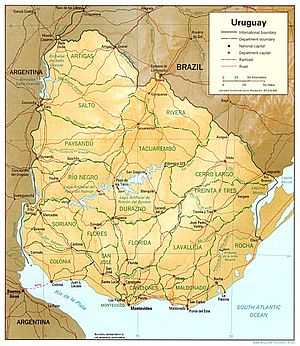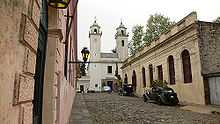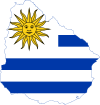Tourism in Uruguay

| |
|---|
|
Communications |
Tourism in Uruguay is an important facet of the nation's economy.
Overlook Relative to its modest land area and population, Uruguay is both a popular international tourism destination and home to a vigorous, domestic tourist trade. Nearly 1.8 million tourists arrived in 2007, and their estimated expenditures in 2007 were of around US$800 million - an increase over 2006 levels of about a third. Domestic expenditures, however, remained around 60% of the nation's tourist activity.[1][2]
The following is a summary of indicators of activity in the nation's tourism sector.
| Internl. tourist arrivals 2007 (x1000)[1] | Internl. tourism receipts 2007[1] (million USD) | Receipts per arrival 2007 (col 2)/(col 1) (USD) | Arrivals per capita per 1000 pop. (estimated) 2007[1][3] | Receipts per capita 2007[4] USD | Revenues as % of exports goods and services[3] 2007 | Tourism revenues as % GDP [2] 2008 | % Direct & indirect employment in tourism[2] 2008 | World Ranking (Tourism Competi tiveness) 2009[2] |
|---|---|---|---|---|---|---|---|---|
| 1,752 | 809 | 462 | 525 | 242 | 11.9 | 3.7 | 10.0 | 63 |
Attractions
Uruguay is home to numerous scenic shores, fishing and hunting areas, hot springs, horse and cattle ranches open for visitors, small towns rich in colonial and early national architectural heritage, and an extensive metropolitan area.
Atlantic Shore
Uruguay's Atlantic coast remains a relatively untapped and unspoiled tourist resource. Its most remote beaches can generally be found in the country's Rocha Department, which includes Uruguay's eastern-most Atlantic approaches. Notable tourist destinations in the area include the oceanfront communities of Cabo Polonio, La Paloma and Punta del Diablo - all of which have attracted growing interest and investment since around 1990.
Maldonado and Canelones
Uruguay's Maldonado Department is home to numerous well-known beachfront tourist destinations, including Piriápolis, Punta Colorada, the Isla de Lobos, Punta Ballena, and the most popular and developed of Uruguay's beach towns, Punta del Este. Growing steadily from the 1896 opening of Antonio Lussich's Arboretum in nearby Punta Ballena, Punta del Este today hosts around one million visitors during the summertime high season (December through February).
Among the surrounding area's chief points of interest, perhaps the best-known is Casapueblo, sculptor Carlos Páez Vilaró's residence, hotel and atelier. Páez Vilaró began his "livable sculpture" in 1958, sometimes adding a new room to host a particular friend. Its Punta Ballena setting is also a popular hang gliding spot.


A number of beach towns in Canelones Department are collectively known as Uruguay's Gold Coast. Known for their sand dunes and the rows of maritime pines planted after 1908 to help prevent beach erosion, these communities have benefited from both their tranquility and proximity to the nation's capital Montevideo via the Inter-Resort Route.
Montevideo

The nation's cultural and economic nerve center, as well as home to 2 out of 5 Uruguayans, Montevideo is home to a rich and diverse architectural and cultural heritage. Its Old City and remains of the colonial-era citadel are within steps of Plaza Independencia, the President's offices at the Estévez Palace, Solís Theatre and the opulent, Italian Gothic Palacio Salvo. The plaza is at the western end of the 18th of July Avenue, the setting for a variety of art deco and belle époque architecture as it passes through Cagancha and Fabini Plazas. Fabini Plaza also leads to the diagonal Libertador Avenue, known for its upscale highrises, rationalist architecture and, at its northern end, the General Assembly of Uruguay.
Plaza Independencia is also a short walk from the Montevideo Esplanade. The Esplanade (Rambla) is one of the city's numerous waterfront districts, which also include Ramírez Beach (home to the Mercosur Common Market headquarters), Pocitos, and a row of similar communities. A new terminal at Carrasco International Airport was completed in 2009, contributing to Montevideo's standing as the major city with the highest quality of life in Latin America.[5]
Colonia del Sacramento


Agricultural lands and desolate shores to the west of the capital along the Río de la Plata lead to Colonia del Sacramento. Founded by the Portuguese Empire in 1680, it remained a point of contention between the Portuguese and Spanish Empires for over a century, and today preserves much of the architecture and cobblestone pavers from the era; the town was declared a UNESCO World Heritage Site in 1995.[6]
The countryside
The Uruguayan hinterland has attracted growing tourist interest in recent decades. Cities along the Uruguay River, such as Salto, Fray Bentos and Paysandú have long been known for their fishing and river boating activities. The surrounding alluvial plains has been interest to ecotourism. The vast expanse of countryside to the west has hosted increasing numbers of visitors, as well. Fans of birdwatching will not be deceived by Uruguay's ornithological diversity, places such as Quebrada de los Cuervos await them. Numerous reservoirs and natural lakes, such as the Laguna del Sauce, host fishing and windsurfing pastimes, and Uruguay's Río Negro is favored by canoers. Numerous others, such as the Yí and Tacuarembó Rivers, also include stretches apt for white water rafting.[7]
Uruguay's farming and ranching tradition has helped foster rural tourism in recent decades. Numerous ranches (Posta del Chuy, for example) have created inns and some also include restaurants that feature each establishment's artisanal jams, cheeses, meats and wines.[7] Uruguay is home to a growing wine industry, and numerous orchards welcome tourists, as well as connoisseurs.[8]
Ethical Traveler Destination
Uruguay was included in both the 2011 and the 2012 lists of "The Developing World's 10 Best Ethical Destinations." This is an annual ranking produced by Ethical Traveler magazine, and is based on a study of developing nations from around the world to identify the best tourism destinations among them. The benchmarking uses categories such as environmental protection, social welfare, and human rights.[9][10][11]
Retirement in Uruguay
Publications such as the Huffington Post[12] recommend Uruguay as a destination for people wishing to retire in peace and enjoyment, and paying reasonable taxes.[13]
See also
External links
References
| Wikivoyage has a travel guide for Uruguay. |
- ↑ 1.0 1.1 1.2 1.3 WTO: World Tourism Barometer
- ↑ 2.0 2.1 2.2 2.3 World Economic Forum: Uruguay
- ↑ 3.0 3.1 UNData: Uruguay
- ↑ World Tourism Organization (2006). "Tourism Market Trends, Annex 12, 2006 Edition" (PDF).
- ↑ La República: Montevideo, la mejor ciudad para vivir de América Latina (Spanish)
- ↑ Turismo del Uruguay
- ↑ 7.0 7.1 Adventure Tourism
- ↑ Luxner, Larry. Wines & Vines: Small Uruguayan wineries making their mark. June 2001.
- ↑ "Ethical travel destinations unveiled: Argentina, Barbados, Chile". The Independent. Relaxnews. 2010-12-10. Retrieved 2010-12-11.
- ↑ Jane Esberg, Jeff Greenwald and Natalie Lefevre. "The Developing World's 10 Best Ethical Destinations". Ethical Traveler. Retrieved 2010-12-11.
- ↑ "The Developing World’s 10 Best Ethical Destinations: 2012". Ethical Traveler. 2012-01-05. Retrieved 2012-01-26.
- ↑ "The Nuts and Bolts: What You Need to Know About Retiring in Uruguay". Huffington Post. 12 August 2013.
- ↑ "Uruguay recommended as retirement destination" (in Spanish). El Observador. 15 August 2013.
| ||||||||||
